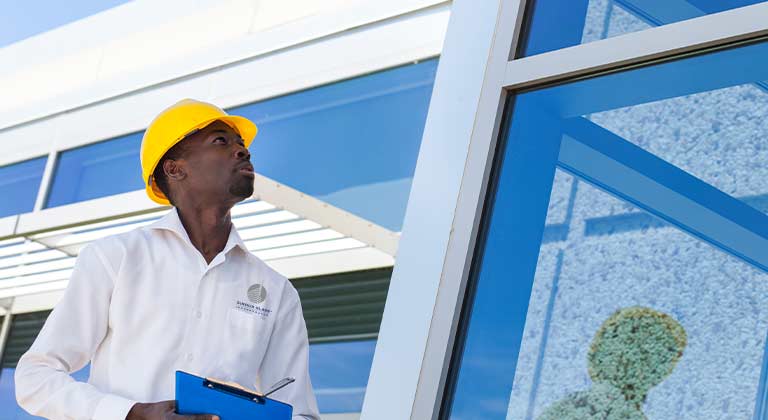
The sudden appearance of cracks, displacement, leaks, deterioration, and corrosion indicate problems with your existing façade. Your ability to prevent any of these from appearing or detecting them early will protect you from future repair expenses. Most importantly, eliminating and preventing these issues will help to ensure the peak performance of your building’s façade.
Here are the top five tell-tale signs of façade problems:
1. Cracks
Cracks are a sure way to tell when there’s been a shift in the structure. Some materials, like drywall and paint or concrete and stucco, develop fine shrinkage cracks; these are normal and nothing to worry about. Signs that indicate more potentially serious problems include cracks wider than a pencil width, vertical cracks in concrete or masonry columns, and cracks near a building’s corners. In Southern California, after any earthquake, x-shaped cracks often appear where towers and lower portions of buildings converge, bump or rub against each other, columns, posts, or any sections of façades located between windows. Enlist the services of a trained engineer to evaluate which cracks are normal and which can indicate any of the significant problems listed below.
2. Displacement
All building materials move in response to fluctuations in temperature. Many materials also move in response to changes in humidity and exposure to moisture. However, obvious displacement of one material situated against another usually indicates a lack of necessary control joints to accommodate expected movements. Left alone, the continued displacement will eventually result in serious damage and can lead to a dangerous situation. Assessing cracks and cladding misalignment is a simple step toward preventing long-term damage to the rest of the façade.
3. Leaks
There wouldn’t be many leakage problems if we never put holes in the walls. The downside is that there also wouldn’t be any windows. Windows can leak through the window parts themselves or from the areas surrounding them. Through-the-window leaks are typically the result of frame corners that were once sealed, and over time and use, eventually become unsealed. Another possibility is that external gaskets may have lost their ability to seal between frames and glass. Window perimeter and casing leaks generally result from inadequate design and/or construction of the joint between the window and the façade. To prevent being frustrated and wasting time and effort, it’s critical to determine the cause of the leak before starting a repair.
4. Material Deterioration
Most materials require periodic maintenance to continue to provide peak performance. Start by looking for hardened or cracked sealant joints, shrinkage of window gaskets, cracks and erosion in mortar joints, and blistered or peeling paint. Pay particular attention to window sills, ledges, and the tops of walls. Any one of these can act as areas that collect water that can create swelling and cracks.
5. Corrosion
Rust is a hidden danger in buildings. The steel in building façades is usually hidden beneath the surface as reinforcement in concrete buildings, and anchors or ties in brick, stone, and terra cotta-clad buildings. When steel rusts, the corroded piece usually expands with enough force to crack the surrounding concrete or masonry, causing it to either sag or fall off completely. Early signs to look for are rust stains and cracks in locations where it’s likely that steel was used as a fastener. Check windows and steel columns in masonry-clad buildings, and in a regular grid in concrete buildings. The sooner you find and repair the corrosion, the less damage you’ll have to restore later.
Visual Inspections are Critical
Visual inspections are critical to the discovery of façade problems. A holistic approach to the prevention of costly repairs starts with an overview of the complete structure. Visually inspect the entire building envelope, roof, walls, basements, building structural systems, and mechanical systems. Making it a routine practice can lead to you identifying the real cause of any problems and preventing further damage and repair expenses.
As a first step, use binoculars and stand back from the building to inspect it from a distance, maybe from across the street. Zoom in to look for issues that would be more challenging to see from up close, (and possibly require the use of a tall ladder), such as cracks, drip marks indicating rust or corrosion, displaced joints, or shifts on the façade and general material deterioration. Visually scan the whole building, checking out all the surfaces from the roof to around the windows on each level, all the way down to the first level.
Next, get up close physically, and inspect the details on anything that looked from a distance like it could be a possible issue. Once you’ve identified what looked to be a problem from afar, target that area of the façade with a close examination.
Note also that what works for one building may not work for another. For example, it wouldn’t be a good idea to start making the same repairs on a structure just because those repairs resolved a similar problem on another building last year. If you see any signs that concern you, contact a façade specialist, licensed engineer or architect with experience in building envelope problems to confirm the accurate source of the problem you’ve identified. Your expert will conduct a more thorough investigation, and prepare drawings and specifications to begin your building’s necessary repair.
